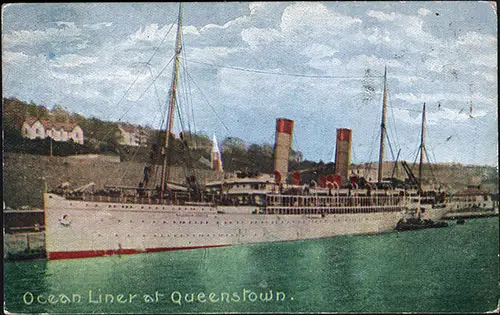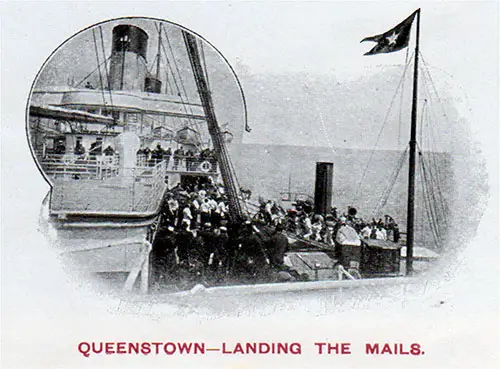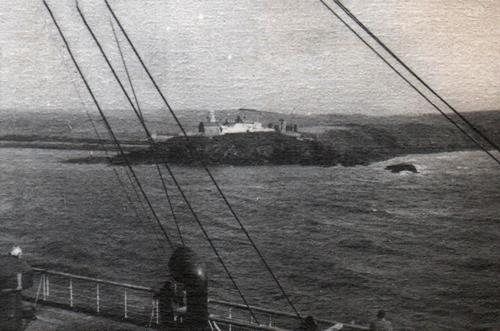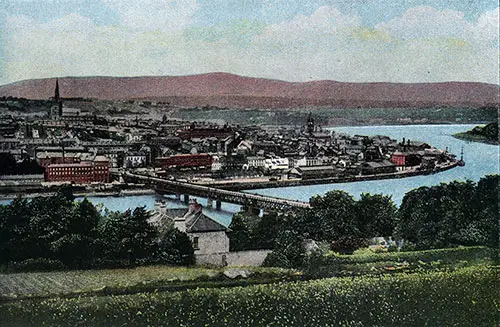Irish Passenger Lists 1883-1954

Ocean Liner at Queenstown circa 1900. | GGA Image ID # 1769cfa7ce
Summary listing of Irish Passengers Lists available at the Gjenvick-Gjønvik Archives originating from or calling on the Ports of Ireland or Northern Ireland. Passenger Lists are organized by Date, Steamship Line, Steamship or Ocean Liner, Class of Passengers, Route of Voyage, and the Ship's Captain.
Moville (Londonderry), Belfast, Galway, Dublin, Queenstown (Cobh), and Dover are the primary steamship passenger ports in Ireland.
Digitized Passenger Lists for the Ports of Ireland:
Queenstown (Cobh)

Landing the Mails at Queenstown (Cobh) circa 1907. | GGA Image ID # 176a55c1fd
Queenstown, the Irish port of call of the Cunard and the White Star (Liverpool Service) Steamers, is a convenient disembarkation point for those desirous of visiting Ireland en route to England and the European Continent. Efficient Tender service is in commission, affording passengers every comfort in landing. Ireland has many scenic attractions, Killarney, etc., and an efficient train service prevails to reach all points of interest. Dublin is reached in about four hours from Queenstown. From Dublin, crossing can be effected to England via Holyhead by the old-established steamers, viz. , the City of Dublin Steam Packet Company, and the London & North Western Ry.
Railway officials meet the steamers on arrival at Queenstown and afford passengers every assistance and information. Those en route to England should inquire for Mr. Wm. Stirling, Agent, L. & N. W. Ry., prepared to look especially after their requirements. Tourists and others landing at Queenstown can obtain all information regarding travel in Ireland on application to the American Office of the Great Southern & Western Ry. (Ireland), No. 287 Fifth Avenue, New York. Queenstown has just been abandoned by the Cunard Line as regards her fastest steamers.
The Cunard Steamship Company has decided to eliminate Queenstown as a port of call for their eastbound mail ships. The slower liners " Caronia" and " Carmania" will call at Queenstown on both their east and westbound trips in the summer. By the saving of time in dropping Queenstown, it is expected that passengers from the " Mauretania" and "Lusitania" will reach London on Monday in time to connect with the nine o'clock mail train via Dover-Calais, which will land them in Paris at 5.50 a. m. Tuesday morning. This will land passengers in Paris from eighteen to twenty-four hours earlier than by the present Cherbourg service. Special carriages for passengers to the Continent via the Great Western Railway will be slipped at Reading, thus cutting out London on the trip to Dover.
Queenstown is the chief port of embarkation for Irish emigrants. They are brought from all parts of the island by rail and are lodged in boarding houses while awaiting sailing. Every week several ships sailing from Liverpool call at Queenstown for passengers, and usually, emigrants do not remain at that port for more than one night.

View of Roches Point Light Near Cobh (Queenstown) circa 1938. | GGA Image ID # 176b0d5d5e
As emigrants board the tender which takes them to the ship, they are given the regular examination by a British board of trade physician in the presence of the American consul or his deputy. The board of trade doctor and the American consular officer go with the emigrants to the ship when their doctor gives them another examination.
This includes both second and third-class passengers, except American citizens, and the examination is made chiefly for trachoma. The American consular officer then makes an inquiry of the ship's doctor regarding the ship's passengers and crew's condition since leaving Liverpool and issues a supplemental bill of health accordingly.
When necessary, emigrants are vaccinated by the ship's doctor during the voyage. Emigrants' baggage is disinfected only when some epidemic disease is prevalent in Ireland.
Under normal conditions, the usual "inspected and passed" label is affixed to the baggage and stamped with the American consular seal by a steamship company employee.
On the whole, the examination as witnessed at Queenstown impressed the committee as perfunctory, but, of course, the necessity of a thorough medical examination is not so great there as at ports where southern and eastern Europeans embark.
Dover Harbor
The new Dover Harbor, covering at low water an area of 600 acres and costing £3,500,000 for its construction, was opened by the Prince of Wales on October 15. The docks have been in the course of construction for 11 years.
The harbor's western arm has been increased in length from 2.000 ft. to 4,000 ft. and an eastern arm constructed measuring 2,924 ft.
A southern breakwater 4,212 ft. long, with two arms, encircles the harbor. On the east, there are two openings into the naval harbor and on the west alongside the Admiralty Pier.
The harbor has required 63,000 concrete blocks, each weighing 25 to 41 tons for the two arms and the breakwater, and 5,000 more as an apron to protect the new works on the outside.
Many thousands of tons of Cornish granite have also been used. It is expected that Dover Harbor will become a port of call for many ocean-going vessels.
Londonderry

View of the Port of Londonderry circa 1904. | GGA Image ID # 176a482b0f
Two steamship companies, the Anchor line, and the Allan line, transport emigrants from Londonderry to the United States. The traffic is not large from this port, and there are few rejections. Emigrants are given a rather perfunctory examination by the board of trade's medical officer when they board the tender, which carries them to the ship at Moville, about 16 miles distant.
Only in cases where the emigrant is defective physically or mentally is a careful examination made. The principal examination of emigrants sailing from Londonderry is made when they reach the steamer at Moville. Here the ship's doctor examines all passengers as they go on board. The American consular agent at London derry attends the first examination.
Emigrants embarking at this port are described as unusually strong and healthy. The Anchor Line manager stated to a representative of the Commission that according to the records of that company, only two passengers had been rejected during the previous six years. The Allan Line manager stated that that company kept no records of this nature, but that in his opinion, not more than six passengers a year are rejected.
Belfast
Belfast Harbour, the premier harbor of Ireland, is at Belfast Lough's head, in latitude 540 36' N., 50 56' W. The time of high water at full and change is 10 hours and 43 minutes. The tide's rise varies from 9 1/2 ft. springs to 7 ft. 8 in. neaps. The prevailing wind is from the south-west to the north-west for nine months of the year.
The harbor is safe, and the sea approach is straightforward, employing a straight channel, which is efficiently lighted by oil so that it is easily navigated by night as well as by day. The depth of water in the channel is 20 feet at average low water.
The docks and basins cover an area of about 136 acres. The harbor consists of about 590 acres of land and 1,528 acres of water or about 2,118 acres in all. A complete system of tramways around the harbor, coal, etc., can be loaded direct from vessels into the railway tracks.
These tramways are connected with all the railway systems of the country. Shipbuilding is encouraged, and the large shipbuilding and engineering works of Messrs. Harland and Wolff, Ltd., and Messrs. Workman, Clark and Co., Ltd., who have a worldwide reputation for the construction of the largest class of ocean-going steamers, are situated on the harbor estate.
The harbor's revenue from all sources, excluding loans, for the year 1906 was £157,000, and after defraying all expenses, the surplus was nearly £20,000.
Moville (1922)
Beginning next month, the Montreal-Glasgow steamers of the Cunard and Anchor-Donaldson Lines will call both eastbound and westbound at Moville, the port of Londonderry, Ireland. It has been many years since Canadian ships called at the Irish port. The new connections to be made will be of great convenience to Irish passengers who wish to reach the United States or Canada at extremely moderate rates.
The Saturnia, sailing from Glasgow on March 24, will stop at Moville on her way to Halifax, Canada, and Portland, Maine. From the latter port, railroads connect with all parts of the country. In May, her westbound terminal port will be Montreal, with numerous railroad connections to all points in Canada and the United States.
Sailing westward from Montreal on June 23, the Athenia will call at the northern Irish port on her way to Glasgow and offers excellent accommodations at attractive rates to people contemplating a visit to the Emerald Isle. The Saturnia will also make an eastbound call at Moville on her July 14 sailing from Montreal.
The Canadian route lops hundreds of miles off the sea voyage, and the trip up or down the beautiful St. Lawrence River is an experience to belong to and pleasantly remembered.
That most popular route between Liverpool, Queenstown, and Boston will be reopened by the Laconia, of 20,000 tons, which carries three classes of passengers. She is practically a sister-ship to the Scythia.
The Liverpool, Queenstown, New York service will be strengthened by the Samaria, another sistership to the Scythia, and there will be practically a weekly sailing from the Mersey to New York.
Bibliography
Albert A. Hopkins, Ed., Scientific American Handbook of Travel, With Hints for the Ocean Voyage, for European Tours and a Practical Guide to London and Paris, New York: Dunn & Co., Inc., 1910.
Emigration Conditions in Europe, Reports of the US Immigration Commission, Senate Document No. 748, Washington, DC: Government Printing Office, 1911.
Herbert B. Mason, Ed., Encyclopaedia of Ships and Shipping, London: Chichester House, 1908.
Along the Atlantic Coast: Big Cunard Developments (To Call at Moville), in Shipping: Marine Transportation, Construction, Equipment and Supplies, New York: Shipping Publishing Co., Inc., Vol. XV, No. 4, 25 February 1922, pp. 20-21.
⚠️ About Accuracy in Historical Records Research Tip
Context. The GG Archives presents passenger lists as faithfully as possible to the original documents. While OCR is generally accurate, portions of these collections—especially image captions and some transcriptions—are typed by hand and may include typographical or spelling variations. The original manifests themselves also contained clerical inconsistencies (names recorded phonetically, mid-voyage corrections, etc.).
What this means for your research:
- Search variant spellings of names (e.g., “Schmidt/Schmitt/Smith,” “Giuseppe/Joseph”).
- Cross-reference with immigration cards, passport applications, naturalization files, city directories, and newspapers.
- Treat manifests as primary sources with historical quirks—use them alongside corroborating records.
- For place names, consider historical borders and language variants (e.g., Danzig/Gdańsk, Trieste/Trst).
How to cite. When quoting a name from a manifest, consider adding [sic] for obvious misspellings and include a note such as “spelling as printed in original passenger list.”
Need help? If you spot a likely transcription error in captions, feel free to contact us with the page URL and a brief note—we love community input. 🙏
Curator’s Note
For over 25 years, I've been dedicated to a unique mission: tracking down, curating, preserving, scanning, and transcribing historical materials. These materials, carefully researched, organized, and enriched with context, live on here at the GG Archives. Each passenger list isn't just posted — it's a testament to our commitment to helping you see the people and stories behind the names.
It hasn't always been easy. In the early years, I wasn't sure the site would survive, and I often paid the hosting bills out of my own pocket. But I never built this site for the money — I built it because I love history and believe it's worth preserving. It's a labor of love that I've dedicated myself to, and I'm committed to keeping it going.
If you've found something here that helped your research, sparked a family story, or just made you smile, I'd love to hear about it. Your experiences and stories are the real reward for me. And if you'd like to help keep this labor of love going, there's a "Contribute to the Website" link tucked away on our About page.
📜 History is worth keeping. Thanks for visiting and keeping it alive with me.
